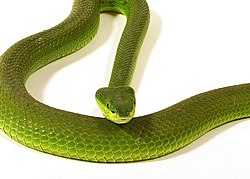Description
Males grow to a maximum total length 575 millimetres (22.6 in), of which the tail is 120 millimetres (4.7 in) in length. Females reach a maximum total length of 1,045 millimetres (41.1 in), with a tail length of 165 millimetres (6.5 in). [4]
Scalation: dorsal scales in 23–25 longitudinal rows at midbody; first upper labial partially or completely fused to nasal; 9–13 upper labials, 1–2 rows of scales separate upper labials from the suboculars; 11–14 scales in a line between supraoculars; supraoculars rarely divided; temporal scales small, strongly keeled; ventral scales: males 153–174, females: 151–180; subcaudals: males 62–79, females 49–61, usually paired, occasionally unpaired shields present among paired series. [4]
Color pattern: head uniform green, dorsum bright green, light ventrolateral stripe present in males, present or absent in females (Maslin [1942:23] says that the ventrolateral stripe is absent, but M.A. Smith [1943:523] states that it is present in males and variable in females), tail spotted with brown; hemipenes without spines. [4]
This page is based on this
Wikipedia article Text is available under the
CC BY-SA 4.0 license; additional terms may apply.
Images, videos and audio are available under their respective licenses.


